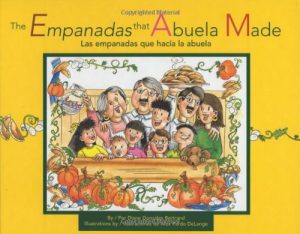 A sweet bilingual story about a family tradition. Baking is always a treat, particularly when you throw family and fun into the mix. In this whimsical look at the making of empanadas, popular children’s author Gonzales Bertrand serves up the festive fun of a family’s effort to concoct the delicious pastries. In the tradition of popular rhymes like “The Old Lady Who Swallowed a Fly,” the laughter and fun rise from page to page. The Empanadas that Abuela Made/Las empanadas que Abuela hacía is filled with humorous cooks and family: Abuela, Abuelo, the cousins, aunts, uncles, and even the family dog join the parade of fluttering flour and swirling sugar. Alex Pardo de Lange fills the pages with offbeat illustrations of blankets of dough and dancing rolling pins.
A sweet bilingual story about a family tradition. Baking is always a treat, particularly when you throw family and fun into the mix. In this whimsical look at the making of empanadas, popular children’s author Gonzales Bertrand serves up the festive fun of a family’s effort to concoct the delicious pastries. In the tradition of popular rhymes like “The Old Lady Who Swallowed a Fly,” the laughter and fun rise from page to page. The Empanadas that Abuela Made/Las empanadas que Abuela hacía is filled with humorous cooks and family: Abuela, Abuelo, the cousins, aunts, uncles, and even the family dog join the parade of fluttering flour and swirling sugar. Alex Pardo de Lange fills the pages with offbeat illustrations of blankets of dough and dancing rolling pins.
food
Triple Banana Split Boy / El Nino Goloso
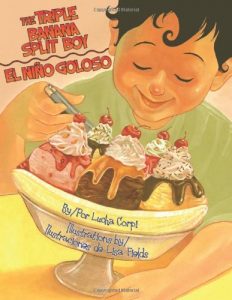 ”How come you can have sweets and I can’t?” Enrique asks the hummingbirds as they flutter over the flowers in the garden. His craving for sugar is getting out of control, and his father has forbidden him to eat anything sweet. Enrique’s birthday is coming up and he won’t be allowed to help his grandma with her baking. It’s not fair! Enrique’s cravings multiply by the minute. Even numbers in his math book start to look like yummy desserts. His life is over! The next day, though, he comes up with an ingenious plan to outwit his father. Unfortunately, his mother soon catches on. But she has a plan of her own. On Mondays and Fridays only, after school, Enrique may have any dessert he likes, but none during the rest of the week. What a sweet deal!On his first outing with his mother, Enrique orders a huge triple banana split, with strawberry, chocolate and vanilla scoops of ice cream, nuts, sprinkles and chocolate syrup. Later that night, Enrique’s stomach aches, and El Coco, a fearsome creature with a huge mouth and sticky hair, haunts his dreams. Enrique’s mother wonders if he will ever learn to eat in moderation. Will he be able to bake with Grandma? And what about having a special treat on his birthday? Lucha Corpi’s poetic prose is combined with Lisa Field’s enticing illustrations in this engaging story that will resonate with kids and their parents as they struggle to balance healthy eating habits with the natural desire for sweets.
”How come you can have sweets and I can’t?” Enrique asks the hummingbirds as they flutter over the flowers in the garden. His craving for sugar is getting out of control, and his father has forbidden him to eat anything sweet. Enrique’s birthday is coming up and he won’t be allowed to help his grandma with her baking. It’s not fair! Enrique’s cravings multiply by the minute. Even numbers in his math book start to look like yummy desserts. His life is over! The next day, though, he comes up with an ingenious plan to outwit his father. Unfortunately, his mother soon catches on. But she has a plan of her own. On Mondays and Fridays only, after school, Enrique may have any dessert he likes, but none during the rest of the week. What a sweet deal!On his first outing with his mother, Enrique orders a huge triple banana split, with strawberry, chocolate and vanilla scoops of ice cream, nuts, sprinkles and chocolate syrup. Later that night, Enrique’s stomach aches, and El Coco, a fearsome creature with a huge mouth and sticky hair, haunts his dreams. Enrique’s mother wonders if he will ever learn to eat in moderation. Will he be able to bake with Grandma? And what about having a special treat on his birthday? Lucha Corpi’s poetic prose is combined with Lisa Field’s enticing illustrations in this engaging story that will resonate with kids and their parents as they struggle to balance healthy eating habits with the natural desire for sweets.
Three Little Tamales
While three little tamales cool off on a windowsill, a tortilla rolls by. “You’ll be eaten. You’d better run,” he tells them. And so the tamales jump out the window. The first runs to the prairie and builds a house of sagebrush. The second runs to a cornfield and builds a house of cornstalks. The third runs to the desert and builds a house of cactus. Then who should come along but Senior Lobo, the Big Bad Wolf, with plans to blow their houses down. Valeria Docampo’s oil-and-pencil illustrations add zest and humor to this rollicking southwestern version of a popular tale.
Let’s Eat!/A Comer! (My Family: Mi Familia)
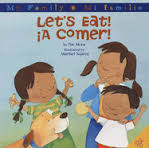
It’s dinnertime. Look at all the food! Es la hora de cenar. ¡Cuánta comida! There are beans, tortillas, Hay frijoles, tortillas, cheese, and even a green salad. queso y hasta una ensalada de lechuga. Enough for the whole family. Suficiente para toda la familia. Let’s sit down and enjoy it together. Vamos a sentarnos y disfrutarla juntos. Let’s eat! ¡A comer! This first book in the new bilingual My Family/Mi familia series will charm readers with its close-knit family—a family that is grateful for its many blessings. Éste es el primer libro de la nueva serie My Family/ Mi familia. Los lectores quedarán encantados con esta familia unida que se siente agradecida por todas sus bendiciones.
Growing Up with Tamales/Los Tamales De Ana (Spanish Edition)
“My name is Ana. Every year, my family makes tamales for Christmas. This year, I am six, so I get to mix the dough, which is made of cornmeal. My sister Lidia is eight, so she gets to spread the dough on the corn husk leaves. I wish I was eight, so that my hands would be big enough to spread the dough just right–not too thick and not too thin.” And so the years pass, and Ana turns eight, ten, twelve, fourteen, sixteen. But every year, big sister Lidia is always two years older. Ana envies her elder sibling and wishes she could do what Lidia does: put just the right amount of meat inside the tamales and roll them up; steam the tamales without scalding herself with the hot, hot steam; chop and cook the meat for the tamales without cutting or burning her hands. When she turns eighteen, though, Ana knows she will keep making tamales and she will be able to do all of the steps herself in her very own factory. When Christmas comes around, Ana will deliver tamales to all of her customers around the world, in delivery trucks that say “Ana’s Tamales.” And maybe Ana will even let Lidia work for her. Gwendolyn Zepeda’s rhythmic prose is combined with April Ward’s bright illustrations to create an affectionate and amusing story about sibling relationships that introduces an important Hispanic holiday tradition–making tamales!
One Potato, Two Potato
Mr. and Mrs. O’Grady are so poor they have just one of everything to share – one potato a day, one chair, one blanket full of holes, and one gold coin for a rainy day. After digging up the last potato in their patch, Mr. O’Grady comes upon a big black object. It’s a pot – no ordinary pot, for what they soon discover is that whatever goes into it comes out doubled! Suddenly the O’Gradys aren’t destitute anymore. But what they really long for is one friend apiece. Can the magic pot give them that?
Our World
OUR WORLD makes it fun and easy for children to learn more about the world around them. With more than 40 maps, 300 images, and hundreds of facts and statistics, this atlas will expand every child’s view of each country around the globe.
Cycle of Rice, Cycle of Life: A Story of Sustainable Farming
 On the island of Bali in Southeast Asia, rice farming is a way of life. The people live in tune with the natural rhythms and cycles of the water and the soil. Ingrained in their community and culture, rice farming connects them to the land and one another. Balinese farmers have planted rice using an intricate system of water sharing and crop rotation for more than a thousand years. Intertwined with their spiritual, social, and day-to-day lives, this system has made Bali a leading producer of one of the world’s most important crops. And because Balinese rice farming respects the balances of nature, it serves as a remarkable example of sustainable agriculture in an increasingly industrialized world. With lush photographs and captivating text, Jan Reynolds explores the traditional world of rice farming on the beautiful island of Bali. Readers of all ages will come away with an enhanced awareness of how we farm, eat, and live today, and the effects these practices have on the world of tomorrow.
On the island of Bali in Southeast Asia, rice farming is a way of life. The people live in tune with the natural rhythms and cycles of the water and the soil. Ingrained in their community and culture, rice farming connects them to the land and one another. Balinese farmers have planted rice using an intricate system of water sharing and crop rotation for more than a thousand years. Intertwined with their spiritual, social, and day-to-day lives, this system has made Bali a leading producer of one of the world’s most important crops. And because Balinese rice farming respects the balances of nature, it serves as a remarkable example of sustainable agriculture in an increasingly industrialized world. With lush photographs and captivating text, Jan Reynolds explores the traditional world of rice farming on the beautiful island of Bali. Readers of all ages will come away with an enhanced awareness of how we farm, eat, and live today, and the effects these practices have on the world of tomorrow.
Boy Dumplings
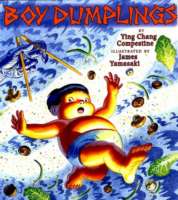
As night falls, one hungry ghost is looking for his dinner. Yum! He spots a plump, delicious-looking boy just right for boy dumplings. Even better, the boy knows the perfect recipe. He sends the ghost all over China for stinky garlic, wormy cabbage, and moldy dumpling wrappers. There’s always one more ingredient the boy tells the ghost to find, but the hungry ghost knows the boy dumplings will be worth it. But when dawn arrives, will this crafty youngster escape — or will the plan he’s cooked up lead him to the cooking pot?
I Love Chocolate
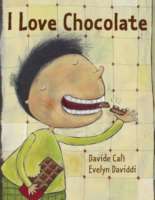
I love chocolates because each one can be a surprise — you have to taste them all to find out what’s inside. It smells good and tastes even better. In I Love Chocolate, readers will experience the taste, smell, and color of the world’s most beloved treat through the eyes of a child. Whether you savor this book slowly or devour it with gusto, readers will appreciate — and crave — the content in this book that is perfect for children and grown-ups, too.
